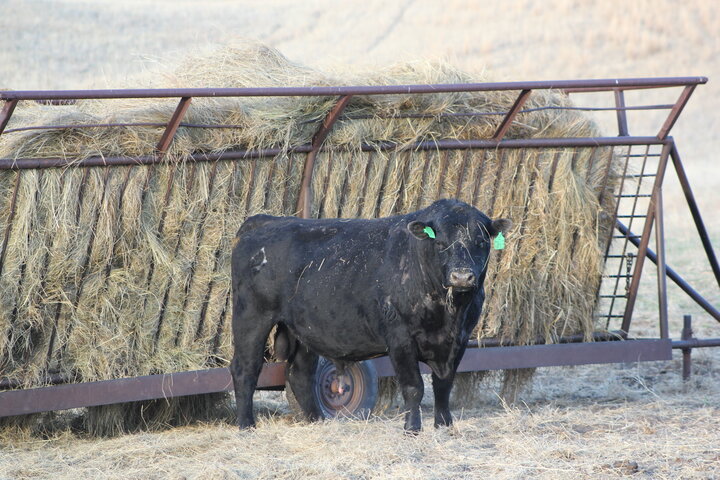A recent BeefWatch article highlighted the importance of timing for a Breeding Soundness Exam (BSE) in our bull battery especially with the winter weather many of our producers have been experiencing. With that in mind, let us dive in a little deeper to how this harsh winter weather can impact bull fertility and how to address management for this next breeding season. With winter weather being very harsh in some areas of the state and country, checking our bull battery is a great thing to consider this time of year. Moving out of winter is a great time to evaluate body condition and make sure that bulls have or had adequate protection from harsh weather. If insults occurred, how are we going to manage those bulls prior to the breeding season?
Cold Weather Management
In regard to cold weather management, ensuring that our bulls have appropriate housing/shelter, bedding, and feed to progress through the winter is key for future success in the spring and moving into the breeding season. Bulls need appropriate housing to provide protection during severe cold weather, which can lead to fertility problems.
Tissue damage due to frostbite will appear as a scab, discoloration, and/or sloughing of the lower portion of the scrotum. Scrotal frostbite will hinder the bull’s ability to raise or lower the testicles for proper thermoregulation, which ultimately will affect sperm production and result in reduced fertility. A study looked at the effect of severity of frostbite on semen quality in bulls and noted that the percentage of bulls that had an unsatisfactory BSE score increased to 26.7% when frostbite was moderate and 88.7% when severe frostbite occurred (Table 1). Evaluating and observing for tissue damage can help a producer identify bulls that need time to heal or allows you time to cull that bull and find a new bull prior to the breeding season.
| Table 1: Effect of severity of frostbite on semen quality in bulls | |||
| Severity of Frostbite | ||
| Breeding soundness score | Mild | Moderate | Severe |
| Satisfactory, % | 89.5 | 48.0 | 2.1 |
| Questionable, % | 9.5 | 25.3 | 9.2 |
| Unsatisfactory, % | 1.0 | 26.7 | 88.7 |
| Adapted from Lardy, 2009 | |||
Frostbite can be prevented by providing heavy bedding (i.e. straw), a shelter, or windbreak for bulls to get out of the weather. Bedding is important to help mitigate the cold by providing insulation from the frozen ground or snow and keeps cattle clean. Storms with bitter cold temperatures and wind are an obvious time of weather stress. Perhaps less obvious as a cause of weather stress are the moderately cold, windy storms with rain, ice or wet snow that lead to wet hair coats on bulls. Wet hair, like wet clothing, cannot insulate effectively. Providing protection from wind and cold temperatures can help bulls maintain body condition rather than using provided nutrition to maintain body temperatures.
Additional information related to bull management during winter can be found in a past webinar (https://youtu.be/uZLCIZplsnk).
Preparing for Next Breeding Season
Following winter, it will be important to make sure we think about scheduling a BSE at least 60 days prior to the start of the breeding season. If there has been an insult (i.e. frostbite) occurring between the end of last year’s breeding season and the start of the next, it will take at least 60 days to recover and make new sperm. The 60-day benchmark gives bulls time to recover and allows time to recheck (usually 2 to 4 weeks later), which will ensure he won’t be impacting the new breeding season, or gives you time to find another bull. Scheduling a BSE in a timely manner is important if damage has occurred. Additional information on bull fertility can be found in a past article, “Managing Bull Fertility Prior to the Breeding Season”.
Body Condition Score
Similar to maintaining body condition score (BCS) of the cowherd, bulls should be in an adequate BCS of 5 to 6 as we move through winter, which allows for greater BCS and potentially semen quality in the subsequent breeding season. Research has shown that bulls in a body condition 5 to 6 have better semen quality than those in a 4 or 7. Much like cows, bull body condition needs to be evaluated as fat cover over the front ribs, brisket, and tail head, also making sure to take into account gut fill (EC 281 http://extensionpubs.unl.edu/publication/9000016365419/body-condition-scoring-beef-cows/).
As you develop rations, or need help from your local extension personnel, including a quality vitamin and mineral program will be important to consider. Some additional nutrition considerations can be found in the Bull Management NebGuide (Breeding Bull Management: It’s a Year-Round Commitment (G2332) (unl.edu)).
Final Thoughts
Because weather insults and injuries can all impact a bull’s ability to breed cows, planning to schedule a breeding soundness exam before each breeding season is important. Providing protection and adequate bedding for bulls during cold weather will ensure scrotums are protected and help maintain body condition over winter. Maintaining weight or gaining the weight back that bulls lost over the breeding season will be important to manage during the winter and into the subsequent breeding season.
Interviews with the authors of BeefWatch newsletter articles become available throughout the month of publication and are accessible at https://go.unl.edu/podcast.

